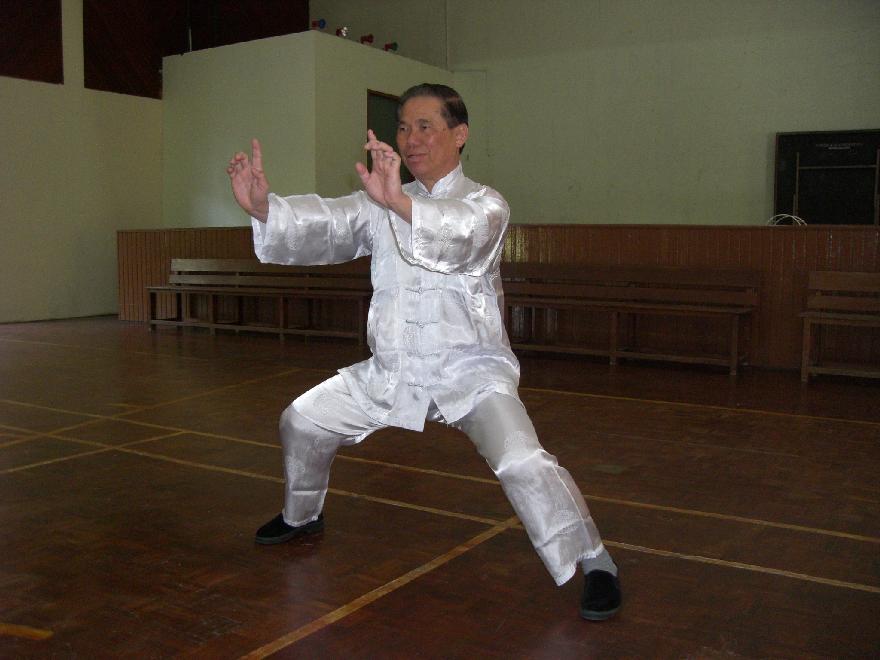FLICKING FINGERS AND DOUBLE HOOKS, SINEW METAMORPHOSIS AND GOLDEN BRIDGE

Golden Bridge
Question 11
I love both Flicking Fingers and Reverse Hanging of Double Hooks. Both are powerful and flowing and make me feel great in a similar way. It made me think that Sinew Metamorphosis was already taught in the Northern Shaolin Monastery.
Why was there a need to develop the 18-Lohan Arts? In particular why was there a need to develop such exercises as Reverse Hanging of Double Hooks, which uses the same approach as Sinew Metamorphosis? Are there big differences between these two?
If I may, one more question. If all things were equal, would a kungfu practitioner exclusively training Sinew Metamorphosis or a kungfu practitioner exclusively training Golden Bridge have an advantage in combat?
Sifu Roeland Dijkema
Answer
Flicking Fingers is a typical exercise in Sinew Metamorphosis. Reverse Handing of Double Hooks is a very powerful exercise in 18-Lohan Art that develops a lot of internal force. Of the exercises in 18-Lohan Art, Reverse Hanging of Double Hooks is closest to Sinew Metamorphosis exercises.
Sinew Metamorphosis was actually taught in the northern Shaolin Monastery. Monks who specialized in Shaolin Kungfu gradually, and often unconsciously modified the Sinew Metamorphosis exercises. Over many centuries of gradual evolution, many of the exercise in Sinew Metamorphosis practiced by warrior monks became quite different from their original version practiced by other monks. These different exercises that were evolved from Sinew Metamorphosis were collective called 18-Lohan Art.
The evolution of these exercises happened gradually and often without the conscious interference of those practicing the exercises. But over a long time, the change was obvious, though the change at any one time was unnoticeable.
Hence, it was not a conscious need to develop the 18-Lohan Art from the 18 Lohan Hands. Changes were made by monks to meet expedient needs and over time the 18 Lohan Hands evolved into the 18-Lohan Art.
It is worthwhile to note that earlier there was a set of exercises called 18-Lohan Art. These were like yoga exercises. I am not sure whether they gradually evolved not what we now have as 18 Lohan Hands, or the great Bodhidharma himself modified them to teach them as 18 Lohan Hands. When the 18 Lohan Hands, in their standing position, were taught, some monks also practiced the earlier 18-Lohan Art, which had some physically demanding postures.
There was no conscious effort to invent Reverse Hanging of Double Hooks. Using the same approach as Sinew Metamorphosis, some warrior monks modified some Sinew Metamorphosis exercises and eventually Reverse Hanging of Double Hooks emerged.
One possibility, which might or might not have happened, was that some warrior monks instead of lifting their arms up as in Reaching Up, dropped their arms down but kept them straight. Next, other monks following this exercise, bent their fingers backward into hooks. Then still other monks found that they could develop more internal force by slanting their body forward at their ankle. These happened over a long period, over many decades or centuries.
Another possibility was that instead of flicking their fingers as in Flicking Fingers, some warrior monks just kept their fingers intact and stayed at their standing position motionlessly. Later other monks following this version of the exercise, bent their fingers backward into hooks. Still later other monks slanted their body forward at their ankles as this generated more internal force.
There are some differences between Reverse Hanging of Double Hooks and similar exercises in Sinew Metamorphosis, as well as between 18-Lohan Art and Sinew Metamorphosis.
Apart from the obvious difference in their outward appearance, there is also some difference in the nature of internal force developed. The internal force in Reaching Up is focused at the side meridians, whereas that in Reverse Hanging of Double Hooks is at the arms. The internal force in Flicking Fingers is relatively flowing, whereas that in Reverse Hanging of Double Hooks is relatively consolidated.
Taking the two sets of exercises as a whole, Sinew Metamorphosis is more consolidated, whereas 18-Lohan Art is more flowing. Sinew Metamorphosis develops a lot of internal force, whereas 18-Lohan Art develops internal force, explode internal force, and promotes agility.
Both Sinew Metamorphosis and Golden Bridge are excellent in developing internal force for combat. The internal force, as well as mental clarity, developed from the two arts is of course also very useful in enriching our daily life.
Theoretically, if all other things were equal, Sinew Metamorphosis will have an advantage over Golden Bridge in combat as well as in daily life. Given the same time in training, Sinew Metamorphosis not only develops more internal force but also of relatively flowing nature and of a greater variety.
You need only 3 minutes to train Sinew Metamorphosis but 10 minutes to train Golden Bridge. The internal force in Sinew Metamorphosis is more flowing than that in Golden Bridge, and generally Sinew Metamorphosis force is consolidated. Sinew Metamorphosis internal force is more varied; it may flow to various organs, bones and tendons, but Golden Bridge force is mainly focused at the arms and legs.
But in real life things are not equal. Not many people, for example, have the opportunity to practice Sinew Metamorphosis or Golden Bridge the way we do. Not many kungfu practitioners have a chance to practice Sinew Metamorphosis or Golden Bridge even in a mediocre way.
For most other people if they practice Sinew Metamorphosis even for a long time, they will not have any internal force. But if they practice Golden Bridge for a long time even when their training is mediocre, they can develop some internal force.
It is ridiculous in our school. If they attend the Sinew Metamorphosis class at the coming UK Summer Camp, they can develop internal force on the very first day!
The questions and answers are reproduced from the thread 10 Questions on Sinew-Metamorphosis in the Shaolin Wahnam Discussion Forum.
LINKS
Courses and Classes
